An owl flew - a cheerful head; so she flew, flew, and sat down, turned her head, looked around, took off and flew again; she flew, flew, and sat down, turned her head, looked around, and her eyes were like bowls, they did not see a crumb! This is not a fairy tale, this is a saying, but a fairy tale ahead.

Spring has come in the winter and, well, drive it with the sun, bake it, and call grass-ant from the ground; the grass poured out, ran out to look at the sun, brought out the first flowers - snowy: both blue and white, blue-scarlet and yellow-gray. A migratory bird stretched out from behind the sea: geese and swans, cranes and herons, sandpipers and ducks, songbirds and a bouncer-titmouse. Everyone flocked to us in Rus' to build nests, live in families. So they dispersed along their edges: across the steppes, through the forests, through the swamps, along the streams.
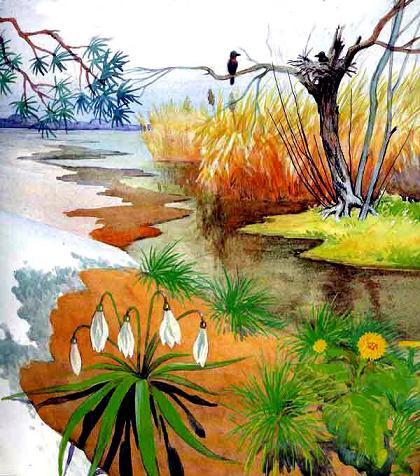
A crane stands alone in the field, looks around, strokes its little head, and thinks: “I need to get a household, make a nest and get a hostess.” So he built a nest right next to the swamp, and in the swamp, in a tussock, a long-nosed, long-nosed heron sits, sits, looks at the crane and chuckles to himself: "After all, what a clumsy born!"

In the meantime, the crane thought up: “Let me, he says, I’ll woo a heron, she went into our family: both our beak and her legs are high. he will rest with his beak - he will pull out his tail, and the beak will get stuck; he will pull out his beak - the tail will get stuck - he forcibly reached the heron tussock, looked into the reeds and asks:
Is the heron at home?
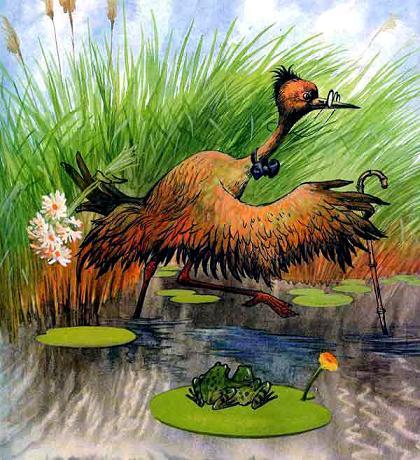
Here she is. What do you need? - answered the heron.
Marry me, said the crane.
If not, I’ll go for you, for the lanky one: you’re wearing a short dress, and you yourself walk on foot, you live stingily, you’ll starve me to death in the nest!
These words seemed insulting to the crane. In silence, he turned, and went home: tyap yes tyap, tyap yes tyap.

The heron, sitting at home, pondered: “Well, really, why did I refuse him, is it better for me to live alone? good word talk over."
The heron went, but the path through the swamp is not close: either one leg will get stuck, then the other. One will pull out - the other will bog down. The wing will pull out - the beak will plant; Well, she came and said:
Crane, I'm coming for you!
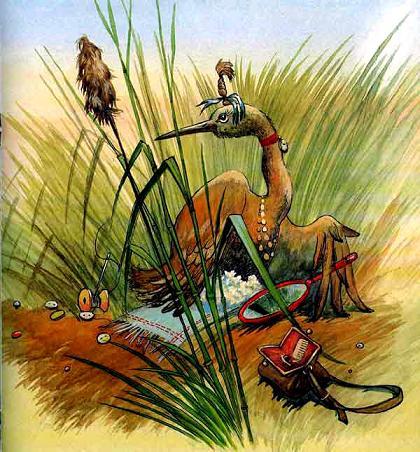
No, heron, - the crane tells her, - I have already changed my mind, I don’t want to marry you. Go back where you came from!
The heron felt ashamed, she covered herself with her wing and went to her tussock; and the crane, looking after her, regretted that he had refused; so he jumped out of the nest and went after her to knead the swamp. Comes and says:
Well, so be it, heron, I take you for myself.
And the heron sits angry, angry and wants to talk with the crane.
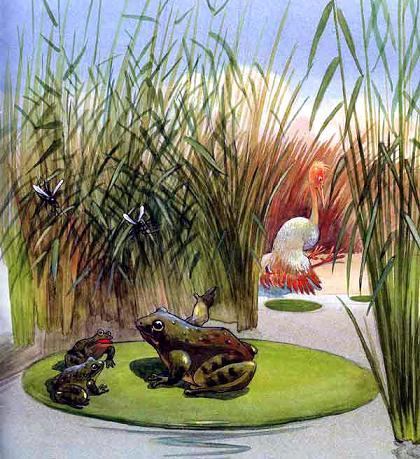
Hear, madame heron, I take you for myself, - repeated the crane.
You take, but I'm not going, - she answered.
Nothing to do, the crane went home again. “So good,” he thought, “now I won’t take her for anything!” The crane sat down in the grass and does not want to look in the direction where the heron lives. And she again changed her mind: "It's better to live together than alone. I'll go make peace with him and marry him."
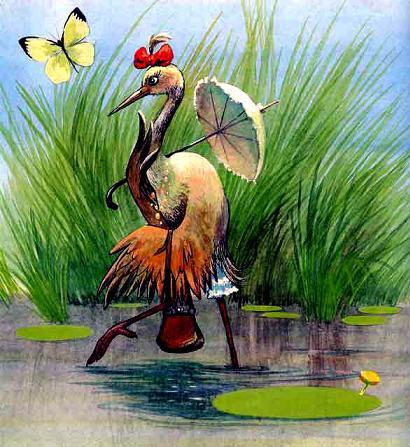
So she went again to hobble through the swamp. The path to the crane is long, the swamp is viscous: one leg will get stuck, then the other. The wing will pull out - the beak will plant; forcibly reached the crane's nest and said:
Zhuronka, listen, so be it, I'm coming for you! And the crane answered her:
Fedor for Yegor, and Fedor would go for Yegor, but Yegor does not take.
Having said these words, the crane turned away. The heron is gone.

He thought, thought the crane, but again he regretted why he had not agreed to take the heron for himself, while she herself wanted; he got up quickly and went again through the swamp: tyap, tyap with his feet, and his legs and tail were bogged down; he will rest with his beak, pull out his tail - the beak will get stuck, and pull out the beak - the tail will get stuck. That's how they go after each other to this day; the path was beaten, but the beer was not brewed.
Russian folk tale in pictures. Illustrations: E. Gromov.
An owl flew - a cheerful head. So she flew, flew and sat down, and turned her tail, but looked around and flew again - flew, flew and sat down, turned her tail and looked around and flew again - flew, flew ...
This is a saying, and this is what a fairy tale is. Once upon a time there lived a crane and a heron in the swamp. They built themselves at the ends of the hut.
The crane became bored of living alone, and he decided to marry.
“Let me go woo a heron!”
The crane went - tyap-tyap! - kneaded the swamp for seven miles.
Comes and says:
— Is the heron at home?
- Marry me!
“No, crane, I won’t marry you: your legs are in debt, your dress is short, you fly badly yourself, and you have nothing to feed me with!” Go away, lanky!
The crane went home without salty slurping. The heron then thought about it:
"Than to live alone, I'd rather marry a crane."
Comes to the crane and says:
- Crane, marry me!
- No, heron, I don't need you! I don't want to marry, I won't marry you. Get out.
The heron wept with shame and returned home. The heron left, and the crane thought:
“In vain did not take the heron for himself! After all, one is boring.
Comes and says:
- Heron! I decided to marry you, marry me!
- No, crane, I will not marry you!
The crane went home. Then the heron thought:
“Why did you refuse? What is it to live alone? I'd rather go for the crane."
She comes to woo, but the crane does not want to. That's how they go to this day to woo each other, but they never get married.
"The Crane and the Heron" is a fairy tale, which is an example of Russian folk art. Today we will retell its plot, and also try to figure out what the main idea was invested in this work.
Saying
So, before us is the work "Crane and Heron". The tale has an introduction, which should be considered in more detail. It describes the flight of an owl-merry head. She sat down, turned her tail, looked around, flew again. Now let's move on to the plot.
Plot
 Understood the hint. As you can see, it can be infinite. Now let's see how the fairy tale "The Crane and the Heron" begins. First of all, the story introduces the reader to the main characters.
Understood the hint. As you can see, it can be infinite. Now let's see how the fairy tale "The Crane and the Heron" begins. First of all, the story introduces the reader to the main characters.
The crane and the heron lived in the swamp. At the ends they built themselves huts. The crane decided to marry, because it became boring for him to live alone. He decided to go and woo the heron. I set off on a long journey, overcame the swamp for as much as seven miles! He came and decided to immediately find out if the heron was currently at home. She answered him yes. Without hesitation, our hero from the threshold invited her to marry him. The beloved refused the hero, arguing that he flies badly, his dress is short, his legs are long and there is nothing to feed him. The heron told him to go home, calling him lanky in the end. Thus parted the crane and the heron.
The story, however, does not end there. The crane became sad and went home. After a while, the heron decided that rather than live alone, it is better to marry a crane. Came to visit our hero. Without thinking twice, she asked him to marry her. The crane, however, was angry with the heron. He said that he did not need her now, and ordered her to go home. The heron wept in shame. Returned home.
After her departure, the crane also thought. I decided that in vain I did not take it for myself. He gathered his strength again and went to visit her. A crane came and said that he had decided to marry a heron and asked to marry him. She, angry, said that she would never accept his offer. Then the crane went home. Heron then thought that it was probably not worth refusing, because it makes no sense to live alone. Again I decided to go for the crane. She set off, came and offered him to be her husband. But the crane has already changed its mind. So they go to woo from one to the other, but still have not married. This is where the story ends.
Morality
 Let's now try to answer the question, what is the meaning of the fairy tale "The Crane and the Heron". From the above story, it is clear that you need to love at the very moment when you are treated mutually, and not wait for the moment, after which there will be no one to feel feelings for. "The Crane and the Heron" is a fairy tale that shows that the inability to meet the other at the right time can lead to incredibly sad results. In addition, it should be said that in this literary work the themes of an extreme degree of stubbornness and pride are very subtly revealed. Each of the heroes is naturally rewarded with overblown pride. Therefore, unfortunately, most likely none of them will have the courage and wisdom to deviate from their principles.
Let's now try to answer the question, what is the meaning of the fairy tale "The Crane and the Heron". From the above story, it is clear that you need to love at the very moment when you are treated mutually, and not wait for the moment, after which there will be no one to feel feelings for. "The Crane and the Heron" is a fairy tale that shows that the inability to meet the other at the right time can lead to incredibly sad results. In addition, it should be said that in this literary work the themes of an extreme degree of stubbornness and pride are very subtly revealed. Each of the heroes is naturally rewarded with overblown pride. Therefore, unfortunately, most likely none of them will have the courage and wisdom to deviate from their principles.
The crane offered the heron to marry him. The heron did not agree, and then changed her mind and herself offered to woo the crane ... So they go to each other all the time, but no one wants to cast aside their pride. This is a funny and endless fairy tale that will amuse the child.
Fairy tale Crane and Heron download:
Fairy tale Crane and Heron read
An owl flew - a cheerful head. So she flew, flew and sat down, and turned her tail, but looked around and flew again - flew, flew and sat down, turned her tail and looked around and flew again - flew, flew ...
This is a saying, and this is what a fairy tale is.
Once upon a time there lived a crane and a heron in the swamp. They built themselves at the ends of the hut. It seemed boring to the crane to live alone, and he decided to marry.
Let me go woo a heron!
The crane went, - tyap-tyap! - kneaded the swamp for seven miles.
Comes and says:
Is the heron at home?
Marry me!
No, crane, I won’t marry you: your legs are in debt, your dress is short, you fly badly yourself, and you have nothing to feed me with! Go away, lanky!
The crane went home without salty slurping. The heron then thought about it and said:
"Than to live alone, I'd rather marry a crane."
Comes to the crane and says:
Crane, marry me!
No, heron, I don't need you! I don't want to marry, I don't marry you. Get out.
The heron wept with shame and turned back.
The crane thought about it and said:
"In vain I did not take a heron for myself! After all, one is bored. Now I will go and marry her."
Comes and says:
Heron! I decided to marry you, marry me!
No, crane, I will not marry you!
The crane went home. Then the heron thought:
"Why did you refuse? What's the point of living alone? I'd rather go for the crane."
She comes to woo, but the crane does not want to. That's how they go to this day to woo each other, but they never get married.
The Crane and the Heron is a Russian folk tale with meaning, in which such human vices as the inability to meet halfway, pride, arrogance and selfishness are ridiculed. The fairy tale The Crane and the Heron can be read online or downloaded in doc and PDF format.
A summary of the fairy tale The Crane and the Heron can begin with the fact that the Crane was tired of loneliness and he decided to woo the heron. The heron approached this question thoughtlessly, and hastily, and answered with a refusal, and even pointed out to the crane its shortcomings. The crane was naturally offended and went home. But the heron did not calm down on this, changed her mind and decided to accept the offer of the crane, but only he had already changed his mind and drove her away. He drove out the heron, and he himself thinks that it is lonely for him to live alone, he decided to go to her again to woo her. And again he was refused by the offended heron. So they went to each other, but did not find agreement.
The main task of the genre and the meaning of the fairy tale The Crane and the Heron is to make fun of human vices, because the heron and the crane mean people and their character. The tale teaches that one wrong word or thoughtless answer can seriously change the fate of a person not in better side. Do not make decisions on emotions, they should be balanced and deliberate. And even if because of this, a discord occurred between people, then it is worth taking courage, compromise and agree with each other. The art of hearing and being heard, mutual understanding between people is often absent in our society, this is what is said in the fairy tale The Crane and the Heron.
Reading the fairy tale The Crane and the Heron is incredibly interesting and easy, it is short, but has no end and no end. Can you discuss with the children about what kind of ending they see? And is there a way out of this situation?
The fairy tale The Crane and the Heron is a good example of such proverbs as: The proud one pouts like a frog, but the miser is crushed by a half, From one word - yes, a quarrel for a century, It’s not good to go on your own - it’s not good, but to send an ambassador - people will know, First think, and there and tell us, Measure seven times, cut once.


